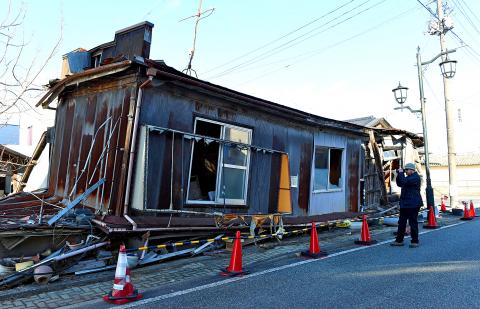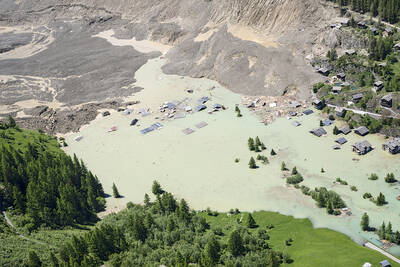Shinichi Niitsuma enthusiastically shows visitors the attractions of the small town of Namie: its tsunami-hit coastline, abandoned houses and hills overlooking the radiation-infested reactors of the disabled Fukushima Dai-ichi nuclear power plant.
Five years after the nuclear disaster emptied much of Japan’s northeastern coast, tourism is giving locals of the abandoned town a chance to exorcise the horrors of the past.
Like the Nazi concentration camps in Poland or Ground Zero in New York, the areas devastated by the Fukushima Dai-ichi disaster have now become hotspots for “dark tourism” and draw annually more than 2,000 visitors keen to see the aftermath of the worst nuclear accident in a quarter century.

Photo: AFP
“There is no place like Fukushima — except maybe Chernobyl — to see how terrible a nuclear accident is,” Niitsuma said, referring to the 1986 accident in Ukraine.
“I want visitors to see this ghost town, which is not just a mere legacy, but clear and present despair,” he added, as he drove visitors down the main street of Namie, which lies just 8km from the stricken nuclear plant.
On March 11, 2011, a magnitude 9 undersea earthquake off Japan’s northeastern coast sparked a massive tsunami that swept ashore leaving 19,000 people dead or missing.
Namie’s residents were evacuated after the tsunami sent the nuclear plant into meltdown and none has yet been allowed to move back over radiation concerns.
Niitsuma, 70, is one of 10 local volunteer guides organizing tours to sights in Namie and other Fukushima communities, including tightly regulated restricted areas. The volunteers take visitors through the shells of buildings left untouched as extremely high levels of radiation hamper demolition work, and use monitoring dosimeters to carefully avoid radiation “hotspots.”
A tsunami-hit elementary school is another stop on the morbid tour. Clocks on the classroom walls are stopped at 3:38pm, the exact moment killer waves swept ashore.
In the gymnasium, a banner for the 2011 graduation still hangs over a stage and the crippled nuclear plant is visible through the shattered windows.
Former high school teacher Akiko Onuki, 61, survived the tsunami that claimed the lives of six of her students and one colleague, and is now one of the volunteer guides.
“We must ensure there are no more Fukushimas,” Onuki said of her reasons for wanting to show tourists her former home.
Chika Kanezawa, a tour participant, said she was “shocked” by conditions she saw.
“TV and newspapers report reconstruction is making progress and life is returning to normal,” said the 42-year-old from Saitama, north of Tokyo. “But in reality, nothing has changed here.”
Dairy farmer Masami Yoshizawa still keeps about 300 cows in Namie. They live off the radiation-contaminated grass in defiance of a government order to have them slaughtered.
As Yoshizawa showed the herd to the gathered tourists, he said he keeps the cattle alive in protest against plant operator Tokyo Electric Power Co and the government.
“I want to tell people all over the world, ‘What happened to me may happen to you tomorrow,’” Yoshizawa said.
The disaster forced all of Japan’s dozens of reactors offline for about two years in the face of public worries over safety and fears of radiation exposure, but the government has pushed to restart reactors, saying the nation needs nuclear power.
English teacher Tom Bridges, who lives in Saitama, said he was able to share victims’ anger and frustration through the tour.
“It’s not a happy trip, but it’s a necessary trip,” he said.
Some local residents still suffering from the grief of losing loved ones and with no hope of returning home, say they have mixed feelings at seeing sightseers tramping through their former hometown.
However, Philip Stone, executive director of the Institute for Dark Tourism Research at Britain’s University of Central Lancashire, said recently that such tangible reminders of disasters serve as “warnings from history.”

The collapse of the Swiss Birch glacier serves as a chilling warning of the escalating dangers faced by communities worldwide living under the shadow of fragile ice, particularly in Asia, experts said. Footage of the collapse on Wednesday showed a huge cloud of ice and rubble hurtling down the mountainside into the hamlet of Blatten. Swiss Development Cooperation disaster risk reduction adviser Ali Neumann said that while the role of climate change in the case of Blatten “still needs to be investigated,” the wider impacts were clear on the cryosphere — the part of the world covered by frozen water. “Climate change and

Poland is set to hold a presidential runoff election today between two candidates offering starkly different visions for the country’s future. The winner would succeed Polish President Andrzej Duda, a conservative who is finishing his second and final term. The outcome would determine whether Poland embraces a nationalist populist trajectory or pivots more fully toward liberal, pro-European policies. An exit poll by Ipsos would be released when polls close today at 9pm local time, with a margin of error of plus or minus 2 percentage points. Final results are expected tomorrow. Whoever wins can be expected to either help or hinder the

Packed crowds in India celebrating their cricket team’s victory ended in a deadly stampede on Wednesday, with 11 mainly young fans crushed to death, the local state’s chief minister said. Joyous cricket fans had come out to celebrate and welcome home their heroes, Royal Challengers Bengaluru, after they beat Punjab Kings in a roller-coaster Indian Premier League (IPL) cricket final on Tuesday night. However, the euphoria of the vast crowds in the southern tech city of Bengaluru ended in disaster, with Indian Prime Minister Narendra calling it “absolutely heartrending.” Karnataka Chief Minister Siddaramaiah said most of the deceased are young, with 11 dead

DENIAL: Musk said that the ‘New York Times was lying their ass off,’ after it reported he used so much drugs that he developed bladder problems Elon Musk on Saturday denied a report that he used ketamine and other drugs extensively last year on the US presidential campaign trail. The New York Times on Friday reported that the billionaire adviser to US President Donald Trump used so much ketamine, a powerful anesthetic, that he developed bladder problems. The newspaper said the world’s richest person also took ecstasy and mushrooms, and traveled with a pill box last year, adding that it was not known whether Musk also took drugs while heading the so-called US Department of Government Efficiency (DOGE) after Trump took power in January. In a